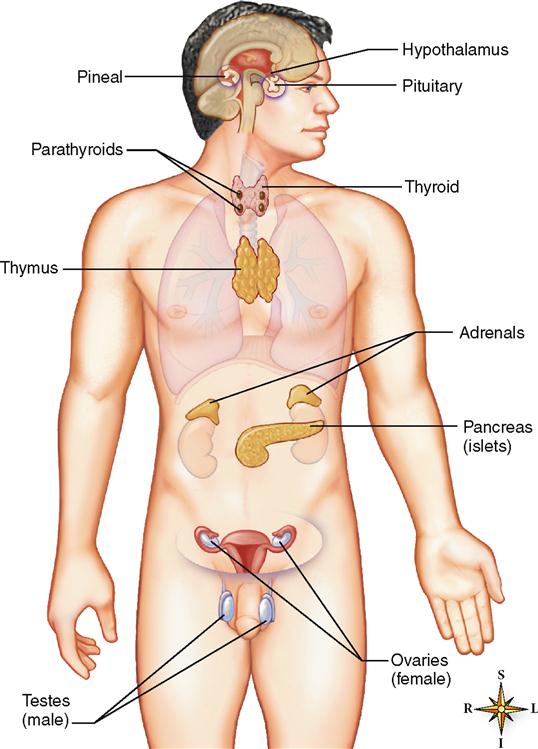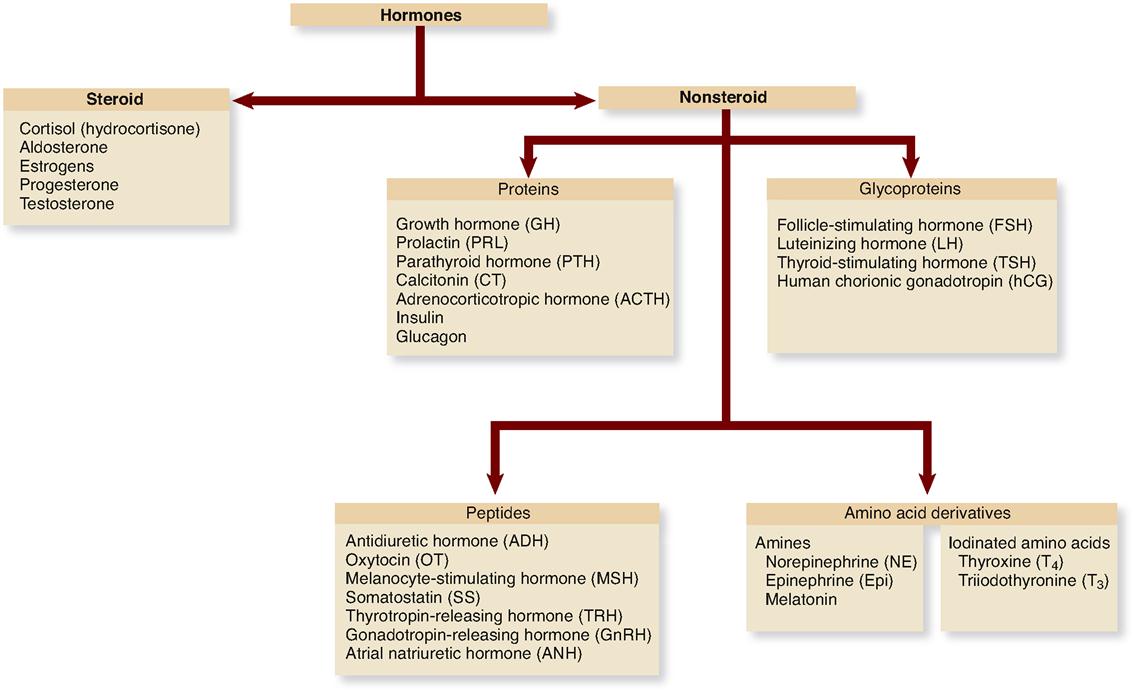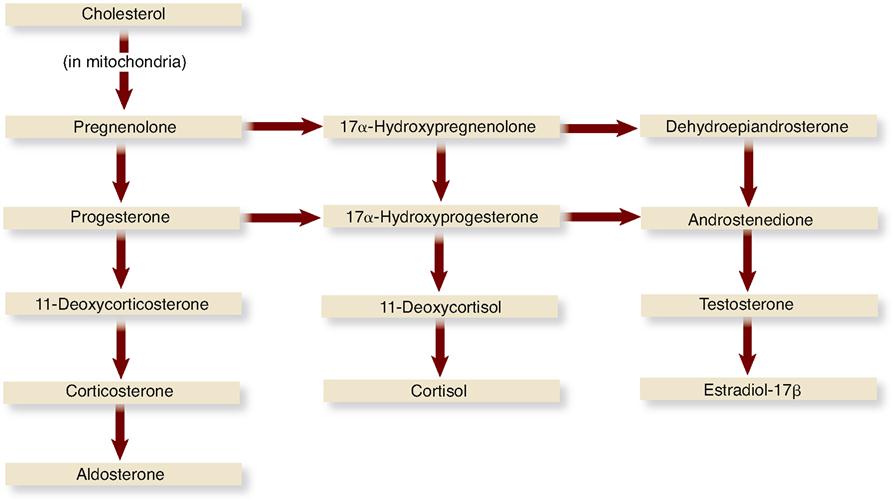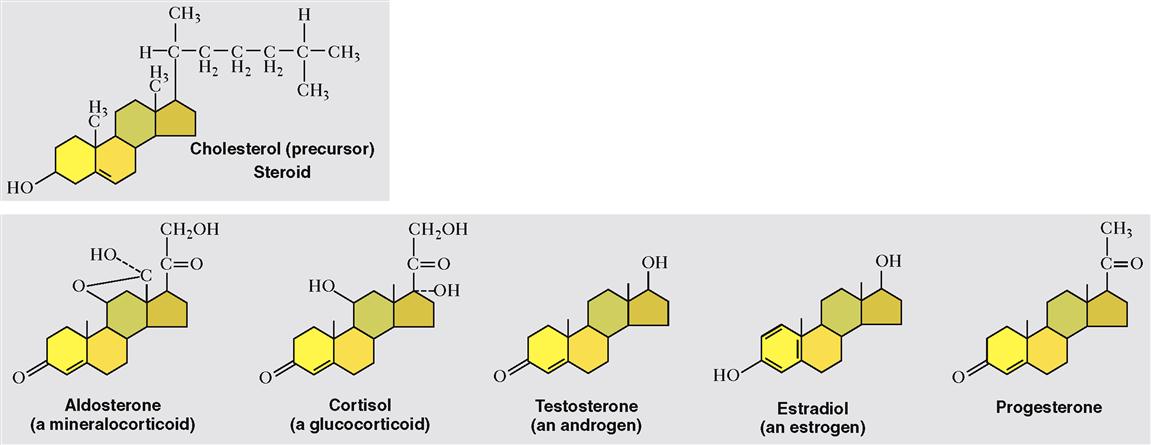Endocrine Regulation
ORGANIZATION OF THE ENDOCRINE SYSTEM
The endocrine system and nervous system both function to achieve and maintain stability of the internal environment. Each system may work alone or in concert with each other as a single neuroendocrine system, performing the same general functions within the body: communication, integration, and control.
Both the endocrine system and the nervous system perform their regulatory functions by means of chemical messengers sent to specific cells. In the nervous system, neurons secrete neurotransmitter molecules to signal nearby cells that have the appropriate receptor molecules. In the endocrine system, secreting cells send hormone (from the Greek hormaein, “to excite”) molecules by way of the bloodstream to signal specific target cells throughout the body. Tissues and organs that contain endocrine target cells are called target tissues and target organs, respectively. As with postsynaptic cells, endocrine target cells must have the appropriate receptor to be influenced by the signaling chemical—a process called signal transduction. Many cells have receptors for neurotransmitters and hormones, so they can be influenced by both types of chemicals.
Whereas neurotransmitters are sent over very short distances across a synapse, hormones diffuse into the blood to be carried to nearly every point in the body. The nervous system can directly control only muscles and glands that are innervated with efferent fibers, whereas the endocrine system can regulate most cells in the body. The effects of neurotransmitters are rapid and short lived compared with the effects of hormones, which appear more slowly and last longer. Table 18-1 compares endocrine structure and function with nervous structure and function (Figure 18-1).
TABLE 18-1
Comparison of the Endocrine System and Nervous System
| FEATURE | ENDOCRINE SYSTEM | NERVOUS SYSTEM |
| Overall Function | Regulation of effectors to maintain homeostasis | Regulation of effectors to maintain homeostasis |
| Control by regulatory feedback loops | Yes (endocrine reflexes) | Yes (nervous reflexes) |
| Effector tissues | Endocrine effectors: virtually all tissues | Nervous effectors: muscle and glandular tissue only |
| Effector cells | Target cells (throughout the body) | Postsynaptic cells (in muscle and glandular tissue only) |
| Chemical Messenger | Hormone | Neurotransmitter |
| Cells that secrete the chemical messenger | Glandular epithelial cells or neurosecretory cells (modified neurons) | Neurons |
| Distance traveled (and method of travel) by chemical messenger | Long (by way of circulating blood) | Short (across a microscopic synapse) |
| Location of receptor in effector cell | On the plasma membrane or within the cell | On the plasma membrane |
| Characteristics of regulatory effects | Slow to appear, long lasting | Appear rapidly, short lived |
Endocrine glands secrete their products, hormones, directly into the blood. Because they do not have ducts, they are often called “ductless glands.” This characteristic distinguishes endocrine glands from exocrine glands, which secrete their products into ducts (see Chapter 6, p. 141). Many endocrine glands are made of glandular epithelium, whose cells manufacture and secrete hormones. However, a few endocrine glands are made of neurosecretory tissue. Neurosecretory cells are simply modified neurons that secrete chemical messengers that diffuse into the bloodstream rather than across a synapse. In such cases, the chemical messenger is called a hormone rather than a neurotransmitter. For example, when norepinephrine is released by neurons, diffuses across a synapse, and binds to an adrenergic receptor in a postsynaptic neuron, we call norepinephrine a neurotransmitter. On the other hand, we call norepinephrine a hormone when it diffuses into the blood (because no postsynaptic cell is present) and then binds to an adrenergic receptor in a distant target cell.
Glands of the endocrine system are widely scattered throughout the body. New discoveries in endocrinology continue to add to the long list of hormone-secreting tissues. However, even the most newly discovered endocrine tissues and their hormones operate according to some basic physiological principles.
In this chapter, we focus our discussion primarily on a few major endocrine glands and their principal hormones. Figure 18-2 and Table 18-2 summarize the names and locations of these representative endocrine glands. After you are familiar with the basic principles of endocrinology and the major examples of glands and their hormones, you will be prepared for additional examples that you will encounter as you continue your study of the human body.

TABLE 18-2
Some of the Major Endocrine Glands
| NAME | LOCATION |
| Hypothalamus | Cranial cavity (brain) |
| Pituitary gland | Cranial cavity |
| Pineal gland | Cranial cavity (brain) |
| Thyroid gland | Neck |
| Parathyroid glands | Neck |
| Thymus | Mediastinum |
| Adrenal glands | Abdominal cavity (retroperitoneal) |
| Pancreatic islets | Abdominal cavity (pancreas) |
| Ovaries | Pelvic cavity |
| Testes | Scrotum |
| Placenta | Pregnant uterus |
HORMONES
Classification of Hormones
Hormone molecules can be classified in various useful ways. For example, when classified by general function, hormones can be identified as tropic hormones (hormones that target other endocrine glands and stimulate their growth and secretion), sex hormones (hormones that target reproductive tissues), anabolic hormones (hormones that stimulate anabolism in their target cells), and many other functional names. Another useful way to classify hormones is by their chemical structure. Because this method of classifying hormones is so widely used, we will briefly describe it in the following paragraphs.
STEROID HORMONES
All of the many hormones secreted by endocrine tissues can be classified simply as steroid or nonsteroid (Figure 18-3). Steroid hormone molecules are manufactured by endocrine cells from cholesterol, an important type of lipid in the human body (see Chapter 2, p. 50). As Figure 18-4 shows, because all steroid hormones are derived from a common molecule, cholesterol, they have a characteristic chemical group at the core of each molecule. Because steroids are lipid soluble, they can easily pass through the phospholipid plasma membrane of target cells. Figure 18-5 outlines the metabolic pathways used by endocrine cells to convert cholesterol into steroid hormones. Examples of important steroid hormones include cortisol, aldosterone, estrogen, progesterone, and testosterone.


NONSTEROID HORMONES
Most nonsteroid hormones are synthesized primarily from amino acids rather than from cholesterol (Figure 18-6). Some nonsteroid hormones are protein hormones. These hormones are long, folded chains of amino acids, a structure typical of protein molecules of any sort (see Chapter 2, p. 52). Included among the protein hormones are insulin, parathyroid hormone, and others listed in Figure 18-3. Protein hormones that have carbohydrate groups attached to their amino acid chains are often classified separately as glycoprotein hormones (Figure 18-6, D).
Another major category of nonsteroid hormones consists of the peptide hormones. Peptide hormones such as oxytocin and antidiuretic hormone are smaller than the protein hormones. They are each made of a short chain of amino acids, as Figure 18-6, B, shows. Figure 18-3 lists examples of peptide hormones.
Yet another category of nonsteroid hormones consists of the amino acid derivative hormones. Each of these hormones is derived from only a single amino acid molecule. There are two major subgroups within this category. One subgroup, the amine hormones, is synthesized by modifying a single molecule of an amino acid—either tyrosine or tryptophan. Amine hormones such as epinephrine and norepinephrine are produced by neurosecretory cells (secreted as hormones) and by neurons (secreted as neurotransmitters). Another subgroup of amino acid derivatives produced by the thyroid gland are all synthesized by adding iodine (I) atoms to a tyrosine molecule (Figure 18-6, C). Figure 18-3 lists examples of hormones derived from single amino acids.
How Hormones Work
GENERAL PRINCIPLES OF HORMONE ACTION
As previously stated, hormones signal a cell by binding to specific receptors on or in the cell. In a “lock-and-key” mechanism, hormones will bind only to receptor molecules that “fit” them exactly. Any cell with one or more receptors for a particular hormone is said to be a target of that hormone (Figure 18-7). Cells usually have many different types of receptors; therefore they are target cells of many different hormones.








